Exterior Before Renovation
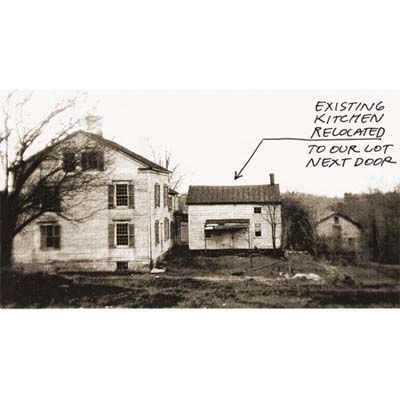
In the late 1940s, the one-and-a-half-story summer kitchen arm of an 1834 Westchester County, New York, farmhouse was sawed off and moved a few hundred yards away. That post-and-beam piece of the building grew into a rambling house in the 1950s, when two one-story additions were built. By the time the current owners bought it a few years ago, the three-bedroom was a dilapidated hodgepodge: “The roof leaked, there were snakes in the basement, and you had to go down a hatch to reach the laundry,” says Rick O’Leary, a designer charged with taking the house from ruin to revival.
Still, the buyers found a lot to like about the house. They were sold on its modest scale; it meant that almost every room had good light and views. They also loved the exposed beams and chestnut floors in the home’s 19th-century core. It felt like a classically built country house—exactly what they had hunted for.
Exterior After Renovation
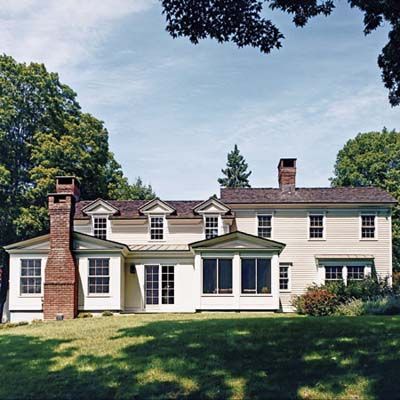
Set on preserving all that was salvageable, the couple decided to renovate—but only after revising history. They handed designers Rick and Liz O’Leary a fictional story line for the place: It would look like an antique house that had been lovingly “modernized” in the 1920s and meticulously maintained. They even had a name for it, Sunset Valley Farm, borrowed from a sign found at an antiques show.
The real house was a real wreck: No insulation and antiquated plumbing and heating systems meant the job wouldn’t fall far from a gut-and-rebuild. But the project would preserve original details and promote Yankee thrift: Who needs a new one when we can fix the one we’ve got?
On the exterior, today, detailing takes cues from the “parent” home, still standing next door, and from traditional New England farmhouse style. These features include cedar clapboards and shingles, and window trim mimicking elements from the original 1834 exterior. Three dormers with six-over-six windows now top the home’s original core, though the roof was raised to fit them in.
Living Room
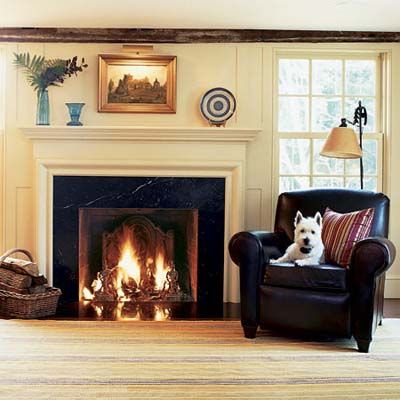
Work began in the living room, the antique core of the new home. The house was stripped to the floor deck and all the walls were reframed and insulated, but in this room, with an original fireplace, contractors Gordon Moesch and Tim Lippert retained or repurposed what they could. This included, Moesch says, “the basic timber structure, the floor structure, the firebox, and an exposed beam.” The ceiling, raised 2 inches from the original beam height, is old-house authentic at 7 feet. After discovering that the chestnut floorboards had been supplemented with a lesser-grade wood, they removed the chestnut and set it aside. After the room was pared down to its bones, the designers finished it in 19th-century-farmhouse style, using wide pine floorboards, flat baseboards, and six-over-six windows with 1×4 casings with a beaded edge. Says O’Leary, “This was the model for the rest of the house.”
Dining Room
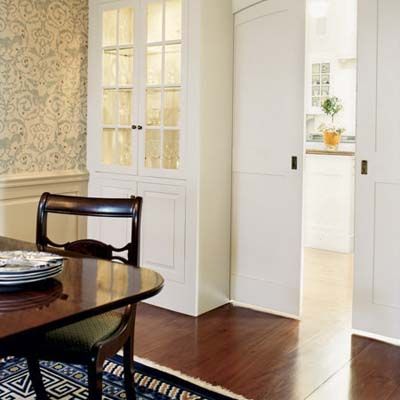
The adjoining dining room sat in a newer wing, and in it the design team saw a chance to work in 1920s hallmarks like built-in china cupboards, which frame paneled and arched pocket doors. The doors conveniently close off the adjacent kitchen when company comes.
Kitchen
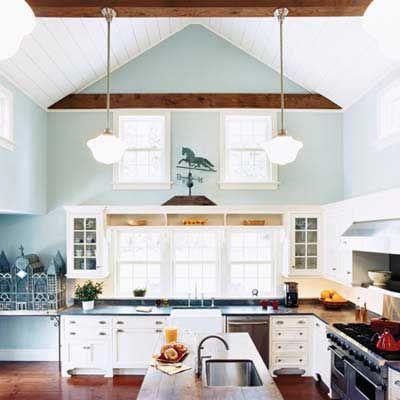
Having relegated the master suite to the new upstairs, the O’Learys set about turning the first-floor one-story former bedroom wing into an expansive new kitchen, bumping up the room’s roof to double height for a soaring ceiling, which is lined with tongue-and-groove boards resembling 19th-century planks. New oak beams act as structural cross-ties, a heftier version of the original exposed timber in the living room. Clerestory windows flood the kitchen with light.
The center island is topped with the old chestnut boards salvaged from the living room floor. Early-20th-century finishes include flat-panel cabinet doors and bin-pull hardware.
Kitchen
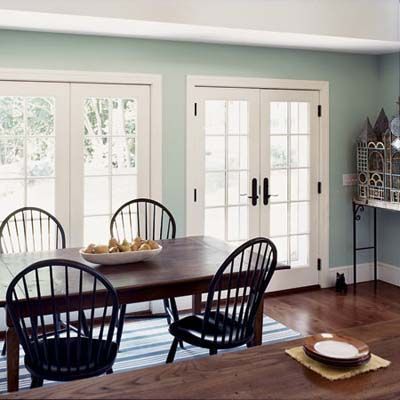
French doors along the kitchen’s west-facing wall provide access to a stone patio and a walkway that
leads to the swimming pool, which is perfectly sited for sunset views over the property’s five acres.
Master Bedroom
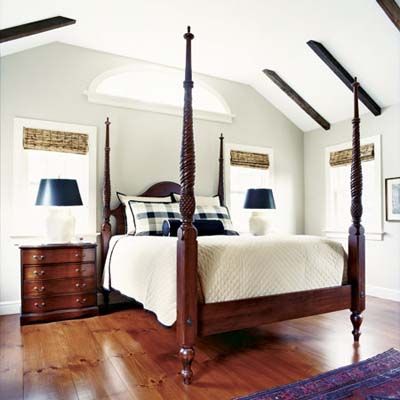
The old kitchen, in the other 1950s one-story addition, offered a practical spot for a combined home office and guest bedroom, with the new first-floor powder room located next door. Bumping up to add another floor on top of it, the O’Learys made way for the master bedroom and bath.
An east-facing arched window in the bedroom invites the morning sun. The wood for the decorative rafters was reclaimed from other sections of the house.
Dressing Area
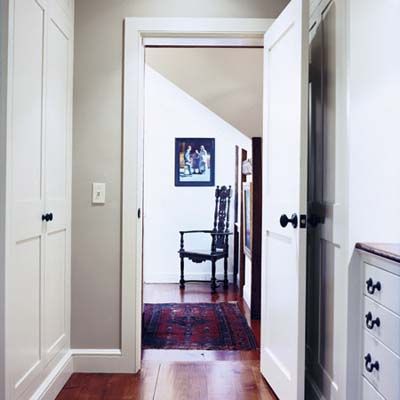
The windowed dressing area outside the master bedroom is lined with built-in storage, such as top-to-bottom clothes closets and a bureau.
Master Bath

The owners, one of whom works in New York City’s residential real estate market and has scouted many a magnificent pre–World War II apartment building, had particular ideas for finishing the master bath. The 1920s-style flourishes they carried to their country house include a Carrara marble countertop and backsplash and a basket-weave marble tile floor. Chrome sconces and nickel faucetry complete the look.
Laundry Room
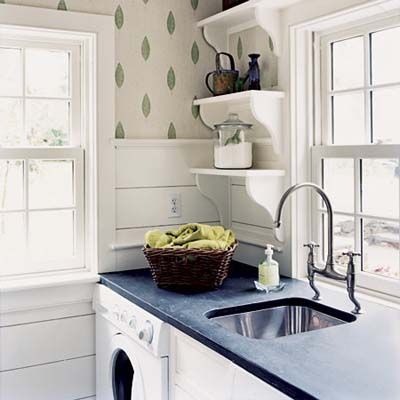
To establish the feel of a 1920s upgrade, the O’Learys designed every room and passageway with details indicative of the period, from fixed shelving and glass-front cabinets to refined fixtures and retro tilework. In the laundry room’s open shelves, curved brackets, painted wainscoting, and soapstone counter give it a time-honored look.
First-Floor Floor Plan
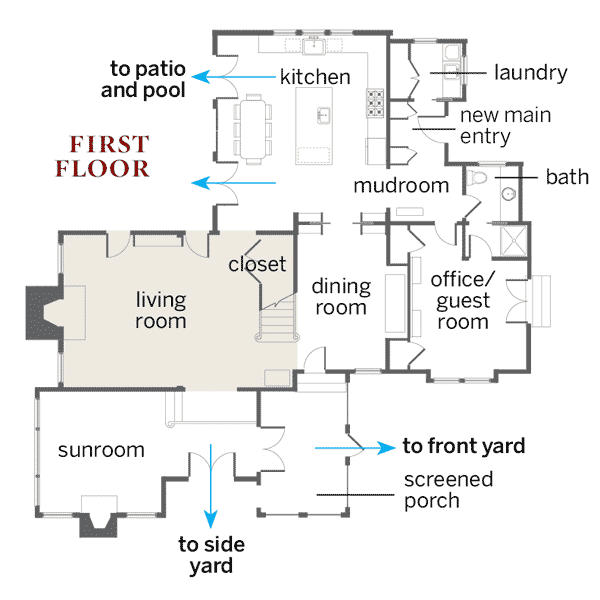
The O’Leary duo, working with architect Kevin Quinlan, created a 3,000-square-foot floor plan that addressed the house’s shortcomings: no proper entryway, a cramped kitchen, a bathroom shortage, and a first-floor master bedroom with little privacy. The reconfiguration gave the owners the big kitchen they really wanted, a home office that would double as a guest room, and a laundry, powder room, and mudroom on the first floor.
Second-Floor Floor Plan
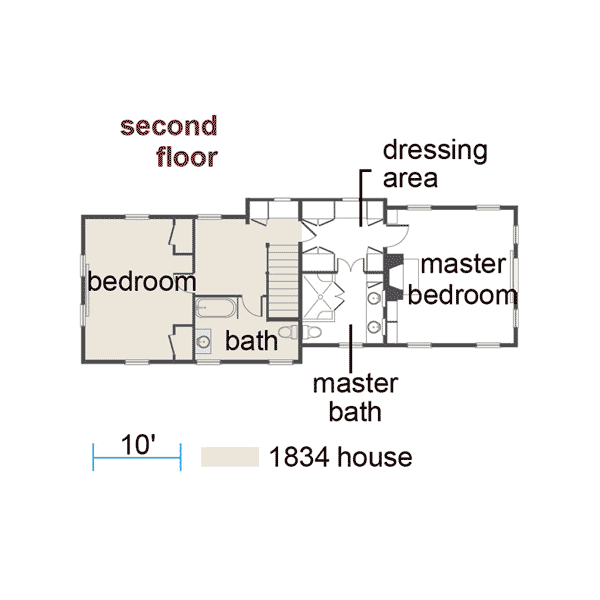
Upstairs, they added a master suite. All of the additional rooms were created while staying close to the house’s original footprint. The design called for adding 150 square feet to the foundation but otherwise building up to make space. “We got lots of square footage inside without overpowering the old scale,” says Quinlan.
“At an open house after the project was finished, I heard one guest say, ‘This is the best example of downsizing I’ve ever seen,'” says Rick O’Leary. Though the home had grown by about 500 square feet, it felt cozier than ever.
